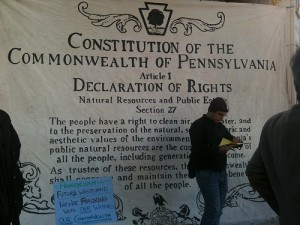"Sustainable public history" means action in Monterey
22 March 2014 – Cody Ferguson

Public history? A Pennsylvania action by the group Marcellus Protest invokes the state’s constitution. Photo credit: Marcellus Protest
After an incredibly engaging and well-attended American Society for Environmental History conference in San Francisco last week, I arrived in Monterey excited to extend the conversation about the connections among environmental history, sustainability, and public history. I did not expect, however, that the term “sustainability” could rouse the activist roots of our profession. “What to do?”, as one of the discussants in the ASEH panel I chaired on “Perspectives on Environmental History” asked in ending his presentation, seemed to be the question for Thursday.
The day began with an innovative presentation from the National Trust for Historic Preservation on climate change, green building and adaptive re-use, and preservation. Facilitated by the Trust’s Priya Chhaya, the panel took a decidedly different tack from conventional conference presentations. It incorporated elements from design practice and involved the audience in a productive workshop about how to communicate the sustainability of preserving and re-using historic buildings. In groups, we were guided through thinking about the potential of preservation in creating sustainable communities and how to make it a more central part of the larger sustainability discussion.
At one point, one of the attendees broke through the wonk and challenged the group to action. Climate change is real. The time for action is now. Public historians are in a unique and powerful place to effect change. This sense of urgency and call to action carried through the rest of the panels in which I took part. It culminated in the post-lunch session in which the NCPH Task Force on Public History and Environmental Sustainability discussed its White Paper addressing how NCPH should respond to issues relating to environmental sustainability and climate change. And on Friday, the discussants on a panel titled “Culture: The Fourth Pillar of Sustainability” encouraged us to expand how we understand the human dimensions of sustainability even further.
The activism of public historians working in a variety of venues and fields impressed and inspired me. Discussing the meaning of what “sustainable” meant and what roles and responsibilities public historians have in addressing climate change and other pressing environmental issues also expanded how I think about sustainability. Thinking about the relationship among historic preservation, sense of place, and community development enriched my understanding of the “social leg” of what is often referred to as the three-legged “sustainability stool.” Often, in discussions of sustainability, the social component loses out to the seemingly more tangible environmental and economic legs. But by linking preservation to economic and community stability, public historians are providing new ways of understanding resilience. Through action, they are implicitly connecting human and social systems into the larger ecology. This is an initiative of central concern for environmental historians and potentially a profound contribution to sustainability thinking born from wedding theory and practice, which are at the heart of public history.



